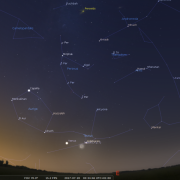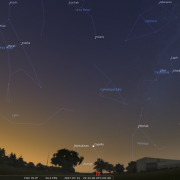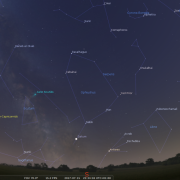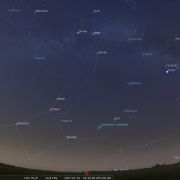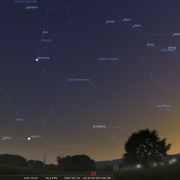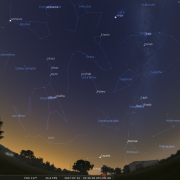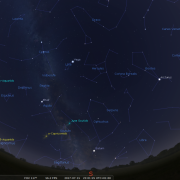
Welcome to the WDAS monthly newsletter for July 2017: a digest of the month's latest contributions to our website. Below you'll find Society News, Sky Notes and In-Focus articles printed in full. There's also future events, and trailers for other articles which appear in full on the website - just a click away!
Society News
Both of the early June Star Parties went ahead as scheduled.
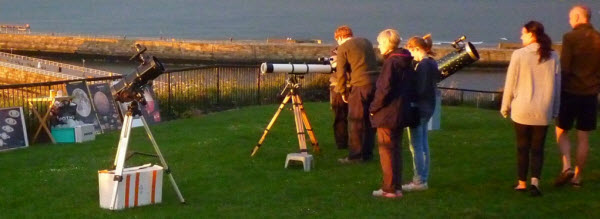
The event on the 3rd drew a reasonable crowd over the duration. Solar observations were initially possible, the sun still above the horizon low in the NW and a noticeable sunspot grouping was visible, which was an unexpected bonus. Once the sun had set attention turned to the moon, a gibbous phase with some lovely detail on show, particularly around the Clavius crater area.
As twilight deepened further Jupiter emerged, a pleasing spectacle, showing great contrast with a hint of colour on the disk. All four Galilean moons were also present. Later on, Saturn was picked up low to the horizon, not brilliant detail it has to be said, but the rings could be made out, much to the satisfaction of the public.
By 23:00h things had quietened down, conditions becoming less conducive for standing around as a chilly ‘off sea’ breeze became more noticeable. Time to pack up.
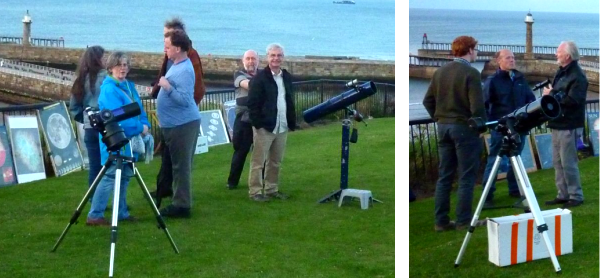
The event held on the 9th was primarily intended to view the full moon rising – as much as anything else. Solar viewing was prevented by a low lying cloud bank in the west; otherwise conditions were similar to the previous week, although somewhat warmer. Public involvement was greater, the full moonrise certainly creating interest attracting a sizable gathering around the scopes. Astronomers tend to regard an ordinary full moon with a little distain; big and bright with little contrast and no shadows. On the upside lunar rays are at their most evident, streaked across the lunar surface emanating from ‘fresher’ impact sites. The dark lunar mares are also fully visible, aspects which still seem to bring joy and amazement to the public.
Having grabbed people’s attention with the rising moon, it was time to flaw them with the two summer planets on show; Jupiter and Saturn. Compared to the previous week Jupiter lacked a little in detail, perhaps seeing was not as good in that part of the sky. Saturn on the other hand appeared somewhat sharper, though still too ‘wobbly’ compared to when at its best; ie higher in the sky. Still, people seemed impressed.
Gradually seeing did deteriorate and by 22:45h thin, high cloud curtailed proceedings. Two events in the space of six days, hopefully there will be some more to follow this summer.
Sky Notes
In this month's Sky Notes:
Planetary Skylights

 Jupiter continues to dominate the late evening sky across in the SW, but is now sliding down toward the horizon. It resides in the constellation of Virgo not too far above its chief star Spica, which will depart from view in July. Observations of Jupiter are always rewarding, even modest instruments will reveal the dark banding across the disk and the Galilean moons; the configuration of which alters each night. Jupiter’s major storm the; the great red spot is apparent in a larger scope, but only when orientated to us, Jupiter rotates in less than ten hours. The Moon lies nearby Jupiter on the 1st and 28th
Jupiter continues to dominate the late evening sky across in the SW, but is now sliding down toward the horizon. It resides in the constellation of Virgo not too far above its chief star Spica, which will depart from view in July. Observations of Jupiter are always rewarding, even modest instruments will reveal the dark banding across the disk and the Galilean moons; the configuration of which alters each night. Jupiter’s major storm the; the great red spot is apparent in a larger scope, but only when orientated to us, Jupiter rotates in less than ten hours. The Moon lies nearby Jupiter on the 1st and 28th
 Saturn, although not as bright as Jupiter, is nonetheless still conspicuous low to the south, a pearly white “star” of magnitude + 0.1. It resides in the constellation of Ophiuchus –the serpent bearer. A modest telescope will reveal the glorious ring system, which is orientated favourably at present; but you will have to be patient at the eyepiece and wait for those steady seeing moments which will make all the difference to the image. Careful observation will reveal a speck of light close by Saturn; this is Titan, Saturn’s major moon. Our moon lies near Saturn on the 6th.
Saturn, although not as bright as Jupiter, is nonetheless still conspicuous low to the south, a pearly white “star” of magnitude + 0.1. It resides in the constellation of Ophiuchus –the serpent bearer. A modest telescope will reveal the glorious ring system, which is orientated favourably at present; but you will have to be patient at the eyepiece and wait for those steady seeing moments which will make all the difference to the image. Careful observation will reveal a speck of light close by Saturn; this is Titan, Saturn’s major moon. Our moon lies near Saturn on the 6th.
 Venus is now putting on a good show in the dawn sky; around 03:30-04:15h. Look for a brilliant object low to the east. Venus resides in Taurus and will be in conjunction with Aldebaran (the fiery eye of the bull) on the 14th. A waning crescent moon then joins the party on the 20th, making for a pleasing vista.
Venus is now putting on a good show in the dawn sky; around 03:30-04:15h. Look for a brilliant object low to the east. Venus resides in Taurus and will be in conjunction with Aldebaran (the fiery eye of the bull) on the 14th. A waning crescent moon then joins the party on the 20th, making for a pleasing vista.
Meteors & Comets

A number of lesser meteor showers occur during July. The Capri-Cornids have 3 maxima, July 8, 15, and 26, but all have Zenith hourly rates (ZHR) of only half a dozen, the same as sporadic rates. Moon light will interfere with the first two dates.
The Alpha-Cygnids peak on July 21st, again rates are barely more than sporadic levels. Cygnus is well placed high in the SSE by midnight.
The Delta-Aquarids are a little more prolific and peak on July 30th with a ZHR approaching 20. The light conditions outside do however restrict observations to a period between midnight and 03:45h.
Comet 2015 V2 (Johnson) should still be visible in binoculars at mag +7.1 or thereabouts. The comet is passing through Virgo and lies directly above Kappa-Virginis on the 1st.
July 2017 Sky Charts
|
Looking North
Mid-July - 22:35h |
Looking South |
|
Looking East
Mid-July - 22:35h |
Looking West
Mid-July - 22:35h |
| Northern Aspect Mid-July - 22:35h |
Southern Aspect Mid-July - 23:00h |
Additional Image Credits:
- Planets and Comets where not otherwise mentioned: NASA
- Sky Charts: Stellarium Software
In-Focus
 In mythology Corona Borealis is said to represent the crown of Dionysus tossed into the heavens to prove his love for Ariadne, daughter of King Minos of Crete. She had played an instrumental role in helping Theseus slay the Minotaur, a creature with the head of a bull on a human body. Ariadne’s mother, Pasiphae had given birth to the creature after copulating with a bull owned by King Minos. In order to cover up the shame, the Minotaur was imprisoned in a labyrinth so complex, neither the Minotaur nor anyone else who ventured in could ever find their way out.
In mythology Corona Borealis is said to represent the crown of Dionysus tossed into the heavens to prove his love for Ariadne, daughter of King Minos of Crete. She had played an instrumental role in helping Theseus slay the Minotaur, a creature with the head of a bull on a human body. Ariadne’s mother, Pasiphae had given birth to the creature after copulating with a bull owned by King Minos. In order to cover up the shame, the Minotaur was imprisoned in a labyrinth so complex, neither the Minotaur nor anyone else who ventured in could ever find their way out.
When Theseus, son of King Aegeus of Athens, came to Crete, Ariadne fell in love with him instantly, telling him of the existence of the Minotaur. Theseus offered to kill the creature, and after consulting Daedalus; designer of the underground maze, she gave him a ball of thread to use in finding his way.

Theseus tied one end to the door of the labyrinth and payed out the thread as he went along, eventually locating the Minotaur and slaying the beast. Re-emerging Theseus duly married Ariadne, sailing off with her, but on reaching the island of Naxos, he deserted her. Inconsolable, there she sat cursing Theseus for his ingratitude, vowing never to marry a mortal again. Thus the god Dionysus came upon her, and taking pity on Ariadne married her, tossing his crown into the heavens to prove he was a god, its jewels turning into stars.
The Constellation
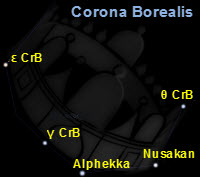 A semi-circle of stars between Boötes and Hercules marks the golden crown worn by Princess Ariadne of Crete when she married the god Dionysus. The crown is said to have been made by Hephaestus, the god of fire, and was studded with jewels from India
A semi-circle of stars between Boötes and Hercules marks the golden crown worn by Princess Ariadne of Crete when she married the god Dionysus. The crown is said to have been made by Hephaestus, the god of fire, and was studded with jewels from India
The constellation of Corona Borealis itself is small but recognizable, with only four stars brighter than magnitude 3.00. It was first catalogued by the Greek astronomer Ptolemy in the 2nd century. Its brightest star is officially called Alphecca from the Arabic name for the constellation, although it is also known as Gemma, the Latin for ‘jewel’.
Alpha Coronae Borealis is the brightest of the seven stars that make up Ariadne’s crown. It is an eclipsing binary star classified as an EA variable, with a period of 17.36 days. The star has an apparent magnitude that varies between 2.21 and 2.32. It is approximately 75 light years distant.
The second brightest star in Corona Borealis, Beta Coronae Borealis is 114 light years distant; Its traditional name is Nusakan. It is a spectroscopic binary, with a period of 10.5 years as well as being a variable star with a period of 18.5 days, varying between 3.65 and 3.72 magnitudes. Alpha-2 Canum Venaticorum variables are main sequence stars of spectral class B8 to A7 that are chemically peculiar and have strong magnetic fields and strong strontium, silicon or chromium spectral lines. They are named after a star in the Cor Caroli system in the nearby constellation Canes Venatici.
T Coronae Borealis is a recurrent nova, sometimes also known as the Blaze Star. It is a spectroscopic binary with a period of 227.6 days. The star usually has a magnitude of about 10-10.8, but in May 1866 it reached magnitude 2 and magnitude 3.0 on February 9, 1946. T Coronae Borealis is a red giant. It belongs to the spectral type M3III and is approximately 2,000 light years distant. Rho Coronae Borealis is a yellow dwarf star with an apparent magnitude of 5.4. It belongs to the spectral class G0-2 and is considered a solar twin, with almost the same mass, luminosity and radius as the Sun. In 1997, a planet was discovered in the star’s orbit. It lies 56.2 light years distant.
R Coronae Borealis is a yellow supergiant star, belonging to the spectral class F7, with an apparent magnitude of 6.46. It is about 6,000 light years distant. It is a variable star, with its brightness fading by several magnitudes at irregular intervals.R Coronae Borealis serves as a prototype of a class of stars known as the RCB variables. The star’s variability is the result of a cloud of carbon dust created in the line of sight that dims the star’s apparent visual magnitude by several magnitudes. the apparent magnitude ranges from 5.71 to 14.8. Due to the dramatic changes of brightness, R Coronae Borealis is also known as the Fade-Out Star or Reverse Nova.
Kappa Coronae Borealis is an orange subgiant belonging to the spectral class K1 approximately 101.5 light years from Earth. It has an apparent visual magnitude of 4.82. A giant planet was discovered in the star’s orbit in 2007.
There are no readily observed deep sky objects in Corona, but the galaxy cluster Abell 2065; a densely populated cluster some 1 and 1.5 billion light years distant, lies about a degree southwest of the star Beta Coronae Borealis, in the southwest corner of the constellation.
The cluster contains more than 400 galaxies in an area spanning about one degree in the sky and has an apparent visual magnitude of 16.5.
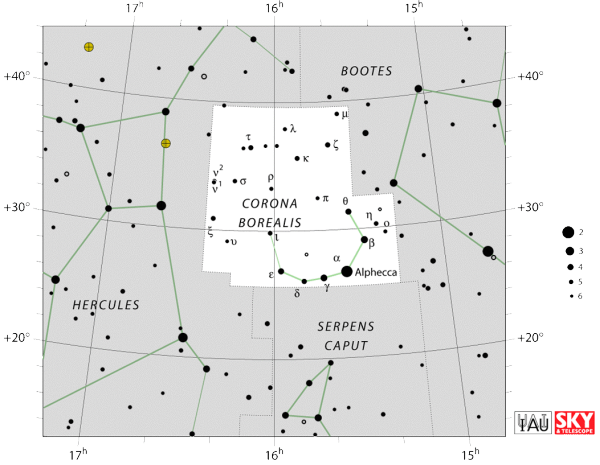
The origin of the name Boötes is a little unclear, but may be derived from a Greek word meaning ‘noisy’ or ‘clamorous’, referring to the herdsman’s calling his animals or alternatively from the ancient Greek meaning ‘ox-driver’, from the fact that Ursa Major was sometimes visualized as a cart pulled by oxen.
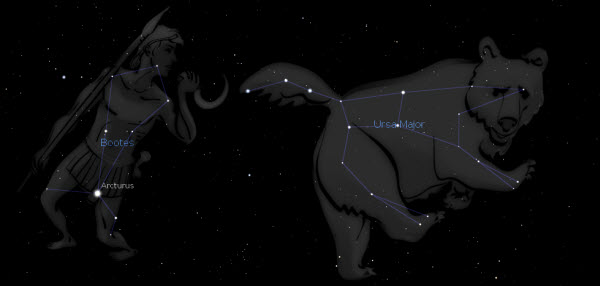
The Greeks also knew this constellation as Arctophylax, translated as Bear Watcher, Bear Keeper or Bear Guard. In any event this constellation (pronounced Boh-oh-tease) is closely linked in legend with the Great Bear, Ursa Major, because of its position behind the bear’s tail. Later astronomers have given Boötes two dogs, in the form of the neighbouring constellation Canes Venatici but they were not part of the original Greek visualization or legend.
 Another legend identifies Boötes with Icarius, a grape grower who invited the god Dionysus to inspect his vineyards. Dionysus was so impressed he taught Icarius how to cultivate vines and make wine. Icarius produced such good wines that he decided to invite his shepherd friends to try it. Not knowing what they were drinking, they all became very, very intoxicated; suffering from bad hangovers the following day and accused Icarius of trying to poison them, killing him in revenge near his vineyard. Icarius’s dog Maera fled home howling and led Icarius’s daughter Erigone to where the body lay beneath a tree. In despair, Erigone hanged herself from the tree and the dog drowned itself in a nearby stream. (a Greek tragedy if ever there was one) Dionysus was so saddened by the killing of his friend that he placed him in the sky as the constellation Boötes, according to some Erigone and Maera, too, were placed in the heavens as the constellations Virgo and Canis Minor.
Another legend identifies Boötes with Icarius, a grape grower who invited the god Dionysus to inspect his vineyards. Dionysus was so impressed he taught Icarius how to cultivate vines and make wine. Icarius produced such good wines that he decided to invite his shepherd friends to try it. Not knowing what they were drinking, they all became very, very intoxicated; suffering from bad hangovers the following day and accused Icarius of trying to poison them, killing him in revenge near his vineyard. Icarius’s dog Maera fled home howling and led Icarius’s daughter Erigone to where the body lay beneath a tree. In despair, Erigone hanged herself from the tree and the dog drowned itself in a nearby stream. (a Greek tragedy if ever there was one) Dionysus was so saddened by the killing of his friend that he placed him in the sky as the constellation Boötes, according to some Erigone and Maera, too, were placed in the heavens as the constellations Virgo and Canis Minor.
The Constellation
Arcturus (Alpha Boötis) meaning means ‘bear guard’ is a red giant (K1.5 IIIpe) located about 37 light years away. It is the 4th brightest star in the night sky overall with an apparent magnitude of -0.04. It is approximately 28 times bigger than our sun around 25 million miles in diameter, 1.5 times more massive, and at least 110 times more luminous. The star’s location on the celestial equator also makes it easy to spot from both hemispheres, and from northern locations can be found by following the arc of the Big Dipper’s handle away from asterism’s “bowl”.
Arcturus is believed to a member of the 52-strong Arcturus Stream, a small group of stars that is moving perpendicularly through the plane of the Milky Way. Indeed Arcturus is moving through space pretty rapidly relatively to us, (proper motion) Half a million years ago Arcturus was just about visible to the naked eye, our paths since then has brought Arcturus to a position of prominence in the night sky, so that it is now at its brightest. Arcturus will continue to move the Moon’s diameter every two millennia until half a million years hence it will once again be just another stellar face in the firmament. Arcturus is also a member of the Local Fluff, or more precisely, the Local Interstellar Cloud, a 30-light-year-diameter interstellar cloud through which the entire solar system is currently moving.
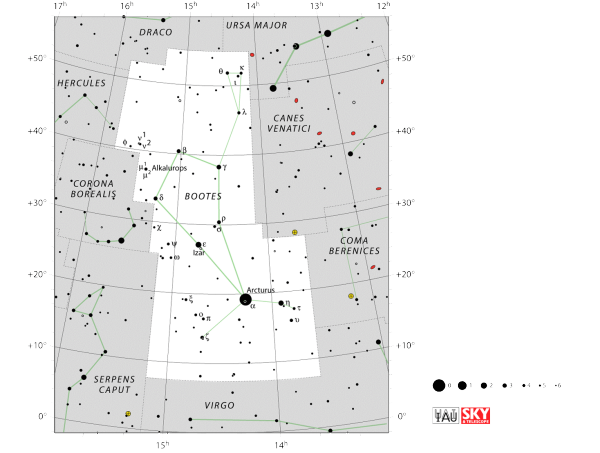
Arcturus has been studied extensively, being the nearest orange giant star to ourselves, and even been able to measure the amount of heat we receive from it; equivalent to that emitted from a single plumbers candle placed around 5 miles away!
Izar (Epsilon Boötis), the second brightest star in Boötes (magnitude of 2.37), is a binary star found 300 light years away. Its primary component is an orange giant, while its smaller companion is a faint blue-green colored star.
Muphrid (Eta Boötis), the constellation’s third brightest star (magnitude 2.68), is a yellow-white subdwarf located 37 light years away. It is approximately 3 times the size of our sun, 1.5 times more massive, and 9 times brighter.
Nekkar (Beta Boötis) is a yellow giant (G8 IIIa) star located about 220 light years away from Earth. Nekkar is a flare type variable star, and can brighten dramatically in the space of just a few minutes. It is at around 250 million years old, at least 21 times bigger than the Sun, and anything between 170 and 195 times as luminous, depending on its state of variability at any given time.
Seginus (Gamma Boötis) is located about 85 light years away, and is classified as a Delta Scuti variable star with an A7III classification. Delta Scuti variable stars show only marginal variations in brightness, and in the case of Seginus, its magnitude variations of between 3.02 and 3.07 are the result of both rotational and non-rotational pulsations that occur on its surface with a period of only 6.79 hours.

